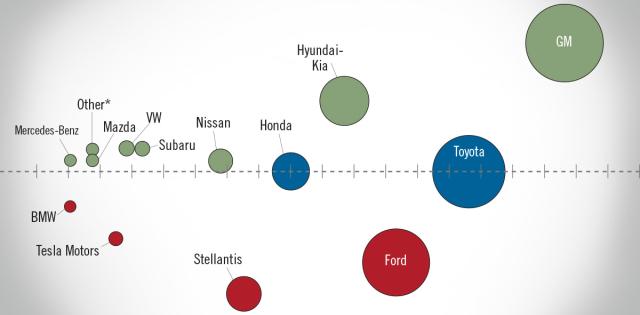The article below is sourced from Bloomberg Wire Service. The views and opinions expressed in this story are those of the Bloomberg Wire Service and do not necessarily reflect the official policy or position of NADA.
Toyota Motor Corp. lowered its production target while sticking to a conservative profit outlook because of a persistent shortage of chips, disappointing analysts who were anticipating an upward revision in the forecast by the world’s biggest carmaker.
Shares fell the most in a month after the manufacturer cut its output target to 9.2 million vehicles from 9.7 million for the fiscal year through March. Operating profit is on track to be ¥2.4 trillion ($16.2 billion) for the period, Toyota said in a statement Tuesday, below analysts’ average estimate of ¥2.98 trillion.
The chip shortages, which stem from Covid-related lockdowns, have challenged the global auto industry, which also faces rising costs for materials and logistics, as well as other supply-chain disruptions. While the weak yen helps Japan’s carmakers boost the competitiveness of vehicles sold abroad and the value of repatriated earnings, they don’t get as much benefit as they used to because the weaker yen amplifies imported costs of raw materials and energy.
“Although the situation is better for chips that are also used for consumer products, there will still be some constraints in semiconductors for automobiles,” Kazunari Kumakura, Toyota’s chief officer in charge of purchasing, said in a briefing. “It appears that the worst is over.”
The carmaker also unveiled a share buyback of as much as ¥150 billion that will run Nov. 2 through May 12. Toyota declined 2.6%, the most since Sept. 30.
For the full year, Toyota raised its sales target to ¥36 trillion, compared with analysts’ estimate of ¥36.3 trillion and the company’s prior guidance for ¥34.5 trillion.
Japan’s currency slumped to a 32-year low in October, and has weakened more than 22% against the dollar this year. Toyota has estimated that each one yen decline pushes its operating profit up by ¥45 billion. The carmaker revised its foreign exchange rate to ¥135 against the dollar from ¥130. The currency was last trading at around ¥148.
Toyota reported operating profit of ¥563 billion for the July-September quarter, compared with analysts’ average projection for ¥765 billion. Profit was ¥750 billion a year earlier. Revenue rose 22% to ¥9.2 trillion in the quarter.
The carmaker booked a ¥97 billion loss on the termination of vehicle production in Russia, including costs for retirement allowances and asset impairments. Toyota in September announced that it would permanently stop production at its lone car plant in the country.
Underscoring the chip shortage, Toyota said Thursday it will temporarily give new car buyers just one smart key instead of two as it seeks to ration semiconductors. The measure will apply to 14 models for sale in Japan, including Crown sedans, Prius hybrids and the battery-electric vehicle bZ4X, for production in November.
Another headache for Toyota is a scandal at its truck and bus unit Hino Motors Ltd. over falsification of engine data that forced it to suspend domestic shipments. Hino said last week full-year operating profit will slump 82%. The manufacturer declined to issue net income guidance, saying it was unable to reasonably assess losses related to the scandal.
“It’s still hard to tell what might happen with suppliers,” Bloomberg Intelligence analyst Tatsuo Yoshida said. “Although there’s less risk now, it’s possible that suppliers may suddenly warn of any issues.”
(A previous version of this story corrected the prior sales guidance figure.)
For more stories like this, bookmark www.NADAheadlines.org as a favorite in the browser of your choice and subscribe to our newsletter here:










